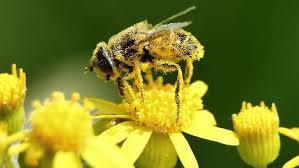
- posted: May 16, 2019
I don’t know about you, but my sinuses are ready to move to Arizona. I mean, I love Spring, and bumble bees are fabulous, but I just need a break from the sneezing, watery eyes, and general feeling of blah. Fortunately, regular chiropractic visits have helped immensely. Not only does a chiropractic adjustment align your spine, adjustments also stimulate adrenal glands to keep your body working optimally.
If you’re curious why the pollen count is so high, this article, written by Ashleigh Schmitz Morley, has never been more relevant.
Spring might have gotten off to a slow start this year, but that hasn't dampened the effects of pollen. In fact, Dr. Clifford Bassett, founder and medical director at Allergy and Asthma Care of New York told weather.com he predicted "a very robust pollen explosion" this spring -- and he wasn't wrong.
According to the doctor, there are a number of reasons for the spring sniffles. “One is the rising long term increase in carbon dioxide and its effect on increased production of pollen,” he said.
“There’s a couple factors,” Dr. Clifford Bassett told weather.com. “One is the rising long term increase in carbon dioxide and its effect on increased production of pollen,” another is what he calls “the priming effect," and the last comes down to a battle of the sexes: pollen-producing male trees are dominating greenspace in many cities.
A study concluded that climate warming and the resultant weather effects are "an important factor" in causing the pollen season to be more intense, and this year Dr. Bassett expects the trend to continue. Climate warming and increased carbon dioxide is having a positive effect on pollen production (and thus a negative effect on those suffering from pollen allergens).
“With this carbon dioxide prevalence, we think certain pollens will be more prevalent and more potent, which is a very major factor,” Dr. Bassett said.
Rising temperatures are also to blame. Dr. Bassett explains that hotter summer seasons can result in a stronger pollen season the following spring. “The summer temperature may have an impact on the following spring season as far as grass and tree pollen, which are the representative and most important pollen in the spring.”
To add insult to injury, the wet winter seasons that feature heavy precipitation are also having an impact on the pollen season.
“In some studies, a very heavy precipitation during the fall and winter may be enough to enhance the pollen production, particularly in grass pollen,” Dr. Bassett said. “So we may see more grass pollens flowering early and more robustly from a very heavy precipitation in fall and winter, which we’ve seen in many areas. When plants are under stress, they may make more flowers and less leaves and therefore they’ll be more pollen.”
Are you reaching for the tissues yet? There is yet another factor contributing to scary pollen forecasts this spring: the priming effect.
As Dr. Bassett describes, the priming effect is when temperatures make big leaps in small periods of time. For instance, when one day the weather is around 30 degrees Fahrenheit and the next the mercury rises to 70 degrees Fahrenheit, the doctor says, “that’s when people really start to suffer.”
The constantly changing and highly varied temperatures cause your body to “[rev] up the immune system and further on down the road, you’re going to be even more hyper-sensitive or hyperactive to the new pollen.” Basically, your body doesn’t take kindly to all of the stop-and-go cues from the weather, which causes increased sensitivity to allergens once they’re released.
Another factor inevitably resulting in more pollen has to do with the types of trees in your environment. When it comes to planning parks and greenspaces, many cities opt for male trees over female trees since they create less mess -- female trees produce seeds that often fall to the ground, making cleaning the sidewalks and grassy areas a pain. Whereas male trees don't, instead they produce pollen. Tom Ogren, who developed OPALS (Ogren Plants Allergy Scale), told NPR that it's better to plant both male and female plants since that will help decrease the amount of pollen in the air.
If your sinuses are ready to move to Arizona, but the rest of you isn’t on the same page, call Gulph Mills Chiropractic Center to schedule a complimentary initial assessment. Curious about what our patients think about Dr. Roger? Check out testimonials from the people Dr. Roger helps!
See what chiropractic can do for you this allergy season! Call Gulph Mills Chiropractic Center: 484-751-5037
Location
Find us on the map
Courtside Square Apartment Building
570 West Dekalb Pike, Ground Floor, Suite 113
King of Prussia, PA 19406, United States
Office Hours
Our Regular Hours
7:30 am - 12:30 pm
3:00 pm - 6:00 pm
10:00 am - 12:30 pm
3:00 pm - 6:00 pm
7:30 am - 12:30 pm
7:30 am - 12:30 pm
3:00 pm - 6:00 pm
Closed
Select Saturdays from 9am to 11am
Apr 27, May 11, Jun 1
Closed
